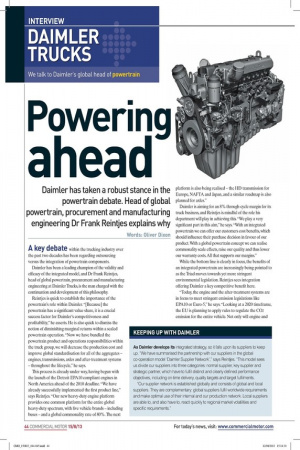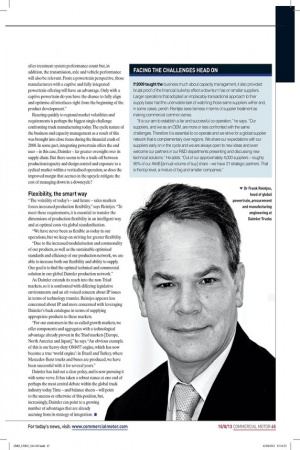INTERVIEW DAIMLER TRUCKS We talk to Daimler's global head of
Page 39

Page 40

If you've noticed an error in this article please click here to report it so we can fix it.
Powering ahead Daimler has taken a robust stance in the powertrain debate. Head of global powertrain, procurement and manufacturing engineering Dr Frank Reintjes explains why Words: Oliver Dixon
A key debate within the trucking industry over the past two decades has been regarding outsourcing versus the integration of powertrain components.
Daimler has been a leading champion of the validity and efficacy of the integrated model, and Dr Frank Reintjes, head of global powertrain, procurement and manufacturing engineering at Daimler Trucks, is the man charged with the continuation and development of this philosophy.
Reintjes is quick to establish the importance of the powertrain's role within Daimler "[Because] the powertrain has a significant value share, it is a crucial success factor for Daimler's competitiveness and profitability," he asserts. He is also quick to dismiss the notion of diminishing marginal returns within a scaled powertrain operation. "Now we have bundled the powertrain product and operations responsibilities within the truck group, we will decrease the production cost and improve global standardisation for all of the aggregates — engines, transmissions, axles and after-treatment systems — throughout the lifecycle," he says. This process is already under way, having begun with the launch of the Detroit EPA10 compliant engines in North America ahead of the 2010 deadline. "We have already successfully implemented the first product line," says Reintjes. "Our new heavy-duty engine platform provides one common platform for the entire global heavy-duty spectrum, with five vehicle brands — including buses — and a global commonality rate of 80%. The next
platform is also being realised — the HD transmission for Europe, NAFTA and Japan, and a similar roadmap is also planned for axles."
Daimler is aiming for an 8% through-cycle margin for its truck business, and Reintjes is mindful of the role his department will play in achieving this. "We play a very significant part in this aim," he says. "With an integrated powertrain we can offer our customers cost benefits, which should influence their purchase decision in favour of our product. With a global powertrain concept we can realise commonality scale effects, raise our quality and thus lower our warranty costs. All that supports our margins."
While the bottom line is clearly in focus, the benefits of an integrated powertrain are increasingly being pointed to as the Triad moves towards yet more stringent environmental legislation. Reintjes sees integration offering Daimler a key competitive benefit here. "Today, the engine and the after-treatment systems are in focus to meet stringent emission legislations like EPA10 or Euro-5," he says. "Looking at a 2020 timeframe, the EU is planning to apply rules to regulate the CO2 emission for the entire vehicle. Not only will engine and
after-treatment system performance count but, in addition, the transmission, axle and vehicle performance will also be relevant. From a powertrain perspective, those manufacturers with a captive and fully integrated powertrain offering will have an advantage. Only with a captive powertrain do you have the chance to fully align and optimise all interfaces right from the beginning of the product development."
Reacting quickly to regional market volatilities and requirements is perhaps the biggest single challenge confronting truck manufacturing today. The cyclic nature of the business and capacity management as a result of this was brought into close focus during the financial crash of 2008. In some part, integrating powertrain offers the end user — in this case, Daimler — far greater oversight over its supply chain. But there seems to be a trade-off between production/capacity and design control and exposure to a cyclical market within a verticalised operation, so does the improved margin that accrues in the upcycle mitigate the cost of managing down in a downcycle? KEEPING UP WITH DAIMLER
As Daimler develops its integrated strategy, so it falls upon its suppliers to keep up. "We have summarised the partnership with our suppliers in the global co-operation model 'Daimler Supplier Network'," says Reintjes. "This model sees us divide our suppliers into three categories: normal supplier, key supplier and strategic partner, which have to fulfil distinct and clearly defined performance objectives, including on-time delivery, quality targets and target fulfilments.
"Our supplier network is established globally and consists of global and local suppliers. They are complementary: global suppliers fulfil worldwide requirements and make optimal use of their internal and our production network. Local suppliers are able to, and also have to, react quickly to regional market volatilities and specific requirements." Flexibility, the smart way
"The volatility of today's — and future — sales markets forces increased production flexibility," says Reintjes. "To meet these requirements, it is essential to transfer the dimensions of production flexibility in an intelligent way and at optimal costs via global standardisation.
"We have never been as flexible as today in our operations, but we keep on striving for greater flexibility.
"Due to the increased modularisation and commonality of our products, as well as the sustainable optimised standards and efficiency of our production network, we are able to increase both our flexibility and ability to supply. Our goal is to find the optimal technical and commercial solution in our global Daimler production network."
As Daimler extends its reach into the non-Triad markets, so it is confronted with differing legislative environments and an oft-voiced concern about IP issues in terms of technology transfer. Reintjes appears less concerned about IP and more concerned with leveraging Daimler's back catalogue in terms of supplying appropriate products to these markets.
"For our customers in the so-called growth markets, we offer components and aggregates with a technological advantage already proven in the Triad markets [Europe, North America and Japan]," he says. "An obvious example of this is our heavy-duty 0M457 engine, which has now become a true 'world engine': in Brazil and Turkey, where Mercedes-Benz trucks and buses are produced, we have been successful with it for several years." Daimler has laid out a clear policy, and is now pursuing it with some verve. It has taken a robust stance at one end of perhaps the most central debate within the global truck industry today. Time — and balance sheets — will point to the success or otherwise of this position, but, increasingly, Daimler can point to a growing number of advantages that are already accruing from its strategy of integration. • Daimler has laid out a clear policy, and is now pursuing it with some verve. It has taken a robust stance at one end of perhaps the most central debate within the global truck industry today. Time — and balance sheets — will point to the success or otherwise of this position, but, increasingly, Daimler can point to a growing number of advantages that are already accruing from its strategy of integration. • FACING THE CHALLENGES HEAD ON
If 2009 taught the business much about capacity management, it also provided brutal proof of the financial bullwhip effect a downturn has on smaller suppliers. Larger operations that adopted an implacably transactional approach to their supply base had the unenviable task of watching those same suppliers wither and, in some cases, perish. Reintjes sees fairness in terms of supplier treatment as making commercial common sense.
"It is our aim to establish a fair and successful co-operation," he says. "Our suppliers, and we as an OEM, are more or less confronted with the same challenges. Therefore it is essential to co-operate and we strive for a global supplier network that is complementary over regions. We share our expectations with our suppliers early on in the cycle and we are always open to new ideas and even welcome our partners in our R&D departments presenting and discussing new technical solutions." He adds: "Out of our approximately 4,000 suppliers — roughly 95% of our AVoB [annual volume of buy] share —we have 21 strategic partners. That is the top level, a mixture of big and smaller companies."











































